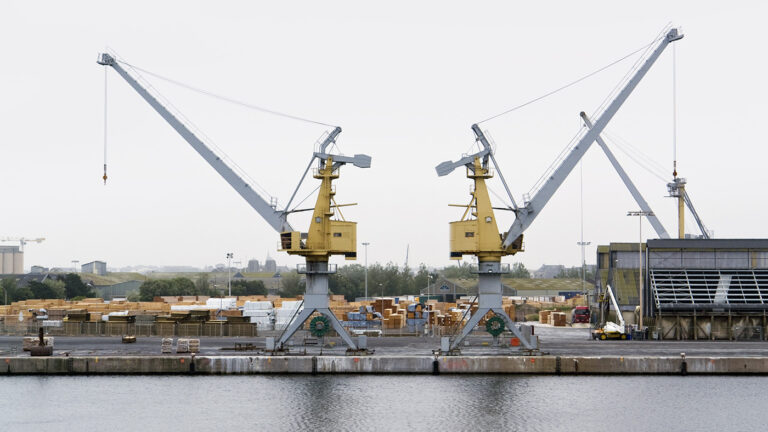Last week at the North American Supply Chain Summit #NASCES2023! Carlos Centurion, President of River Logic, sat down with Lee Devasier, Vice President of Network Strategy and Design at Pitney Bowes, to discuss how Pitney Bowes has been leveraging River Logic’s Digital Planning TwinTM technology to optimize their complex business operations. In this recap, we’ll dive into the key insights from their conversation and learn how Pitney Bowes is harnessing the power of Digital Planning TwinTM to drive value in a rapidly evolving industry.
Pitney Bowes: A Global Shipping and Mailing Giant
Pitney Bowes, a global shipping and mailing company, has a rich history of providing technology, logistics, and financial services to many clients, including small businesses, retailers, enterprises, and government entities. With a strong presence in the e-commerce sector, Pitney Bowes specializes in facilitating the domestic and international transportation and delivery of lightweight e-commerce packages. In recent years, the company has undergone a significant transformation, transitioning its network of facilities from manual operations to highly automated ones.
Lee Devasier, who assumed the role of Vice President of Network Strategy and Design at Pitney Bowes a year ago, shared insights into the company’s operations and his responsibilities. His role encompasses designing Pitney Bowes’ network and facilities, managing transportation networks, and ensuring service performance, including their partnership with the US Postal Service.
The Need for Digital Planning in a Fast-Paced Industry
Lee emphasized the rapid changes and evolving challenges in the shipping and mailing industry. With numerous variables, including pricing, demand, volume, and workforce dynamics constantly shifting, Pitney Bowes needed a solution to help them make informed, agile decisions. Traditional business tools were insufficient to analyze complex scenarios quickly, especially when evaluating the impact of significant customer opportunities.
Empowering Decisions with River Logic’s Digital Planning TwinTM
River Logic’s Digital Planning TwinTM answered Pitney Bowes’ complex challenges. Lee explained that the technology enabled them to gain agility and visibility into the effects of different variables on their network. The capability of including unique constraints into the model allowed Pitney Bowes to combine costing into the constraint modeling, giving users visibility when fixed and variable costs change with volume and mix.
They could quickly assess scenarios, from adding or removing nodes in their network to optimizing facility utilization. The tool allowed them to analyze these scenarios and make data-driven decisions quantitatively.
The team at Pitney Bowes was impressed with the granularity of the assessments River Logic delivered – going down to the day, cube/weight, and truckload level, enabling them to improve their planning process significantly.
Achieving Measurable Results
The results achieved by Pitney Bowes through the implementation of River Logic’s solution were substantial. They removed two facilities from their network, optimizing their use of a newer, highly automated facility. Additionally, they identified the potential to remove a previously considered essential facility, leading to cost savings and improved service. On the transportation side, they saved 5-15% on transportation costs.
These results demonstrated the software’s ability to uncover insights that might not be apparent through traditional analysis methods.
Future Directions: A More Granular Look at the Network
Looking ahead, Pitney Bowes plans to expand its use of modeling to gain a more granular understanding of its network. This includes evaluating the best locations and timing to service customers efficiently throughout the 24-hour cycle. By optimizing their facilities’ utilization on a 24-hour basis, they aim to enhance service while maintaining labor efficiency.
Advice for Others Embarking on a Similar Journey: Embrace Comprehensive Solutions for Enhanced Efficiency
As parting advice, Lee emphasized the importance of considering the ability to solve multiple variables and scenarios quickly. Rather than relying on segmented, isolated tools, businesses should seek solutions like River Logic’s Digital Planning TwinTM that allow them to simultaneously analyze various aspects of their operations. The efficiency and depth of analysis provided by this technology have been a game-changer for Pitney Bowes, offering capabilities beyond what traditional industrial engineering methods could achieve.
In conclusion, Pitney Bowes’ journey with River Logic’s Digital Planning TwinTM highlights the transformative power of advanced analytics and digital planning in optimizing complex business operations. By embracing these practices, companies can adapt to rapidly changing industries, achieve higher efficiency, and unlock new possibilities for growth and competitiveness. Pitney Bowes’ experience serves as a valuable example for businesses seeking to navigate the evolving landscape of logistics and shipping.



